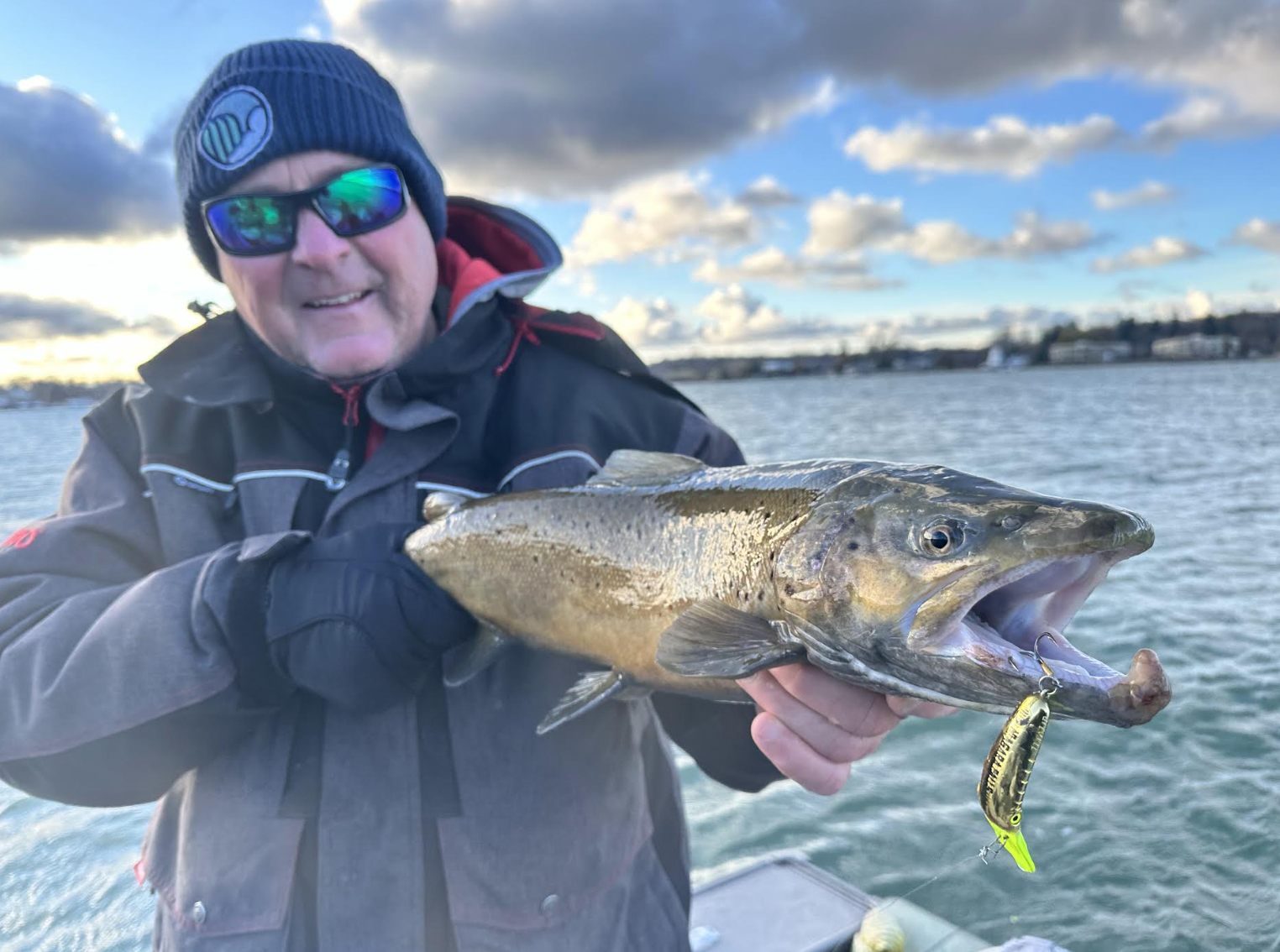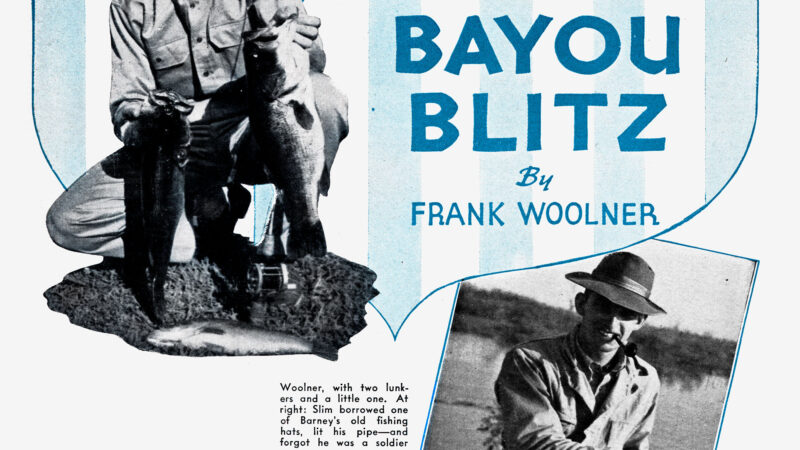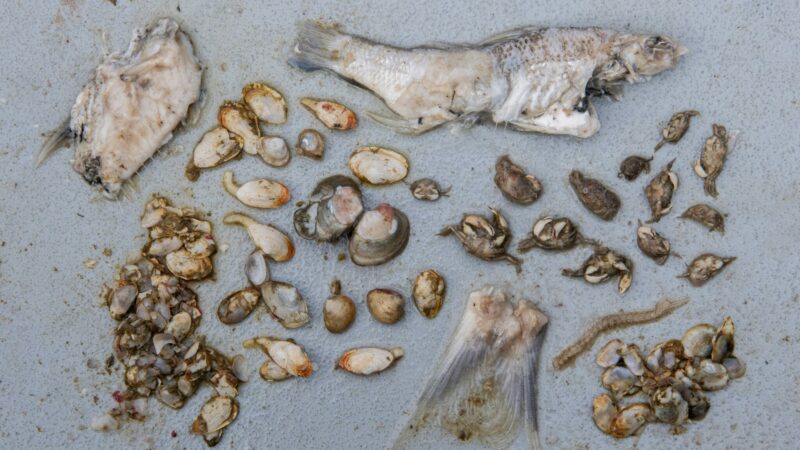Quick Strike Podcast: Why the Flatfish Is the Ultimate Winter Bait
We may earn revenue from the products available on this page and participate in affiliate programs. Learn More ›
Kwikfish, Lazy Ike, Flatfish, Mag Lip. All these lures are essentially the same in design and function. If you’re a salmon angler in the Pacific Northwest or a big-water walleye chaser, you’re probably familiar with them. But if you’re not, you’ll still be familiar with them. I don’t think I’ve ever opened a crusty tackle box at a flea market or rummaged through a lure pile at an antique shop and not found one of these banana-shaped hard baits. The two classic colors I seem to bump into most often are yellow with red polka dots and fire tiger. They have flat, wide faces designed to dig…on the troll, that is. My grandfather didn’t troll, but he still had a few, which leads me to believe many people picked up these odd baits over the years without a real understanding of their function.
Captain Frank Campbell has been guiding on the Niagara River in Western New York for more than 30 years, and it was on his boat one December day nearly a decade ago that I first saw the potency of a flatfish-style lure. And there was no trolling involved. Yes, you can tow these lures under power, but Campbell uses them while drifting. His method will hammer fish in any current-driven water or on still water when the wind is blowing you around. I recently had Campbell on the Quick Strike podcast to dive into the details of flatfish tactics.
For Campbell, his trusty Mag Lips are day savers and day makers, especially in the winter when numb fingers make casting and reeling not so fun. I’ve been out with him many times when only Mag Lips scored bites. The thing is, these classic lures catch a wide variety of species from trout to steelhead, smallmouth to pike, and salmon to walleyes. By incorporating a few into your arsenal and leaning into Campbell’s tips, you can turn winter “slog” days into slay-fests.
Rig It Right
First, let’s break down Campbell’s rig. His main line runs to a three-way swivel. Connected to the second eye of that swivel is 6 to 8 inches of light monofilament, and at the terminal end is tied a 1.5-ounce thin, cylindrical pencil sinker. The lure is tied to 4 to 6 feet of 10-pound fluorocarbon leader, which is then connected to the remaining open eye of the three-way swivel.
The rig is lowered to the bottom and some extra line is paid out to create some scope. Pencil sinkers are designed to thwart snagging on the hard, rocky bottom. As the boat rides the river current, the sinker taps across the bottom creating resistance, while the Mag Lip trailing behind digs and dances. What this presentation allows you to do is stay in the zone for an entire drift, which is helpful in winter when gamefish are often holding tight to the bottom. Though Campbell recommends having a few color patterns on hand, choosing the correct size lure is more critical.
“We have everything on the Niagara from emerald shiners, which are very small, to gizzard shad which can be six or seven inches long,” Campbell says. “It’s important that you match the lure sizes to the primary forage. The exception would be in stained water. I find that if the water’s on the dirtier side, larger Mag Lips produce better.”

Lose Your Belly Hook
Most models of flatfish-style lures featured two treble hooks—one at the tail and one on the belly. Years ago, when I first started fishing with Campbell, I noticed the belly trebles on his Mag Lips were always removed. It turns out that there are several benefits to fishing these baits with nothing but the tail hook.
“After years of fishing these lures, we’ve found that the hookup-to-landing ratio is actually better when you remove the belly hook,” says Campbell. “With two hooks we’d find one would hit the side of the mouth and the other would be pinned to the fish’s cheek or somewhere it wasn’t supposed to be. When that happens, it changes how pressure is being applied to the lure and we’d have a lot of hooks pull out.”
Campbell says when running just the tail hook, most of the time it’s pinned solidly in the corner of the mouth, which is a big plus when fighting hard-charging steelhead and lake trout. He also notes that in winter, you don’t want to spend too much time getting tangled lures out of your net, so removing the belly hooks makes releases faster, which is ultimately better for the fish.
Spool Up with Fluoro
Braided line might reign supreme in terms of overall popularity among anglers these days, but when pulling flatfish-style lures, Campbell prefers to spool up with fluorocarbon. One reason is he prefers a line with some stretch to counter hard strikes during fast drifts. Another is he believes braid can give his Mag Lips too much action.
“Braid can actually over-activate the lure,” Campbell says. “The hook also tends to pull out more easily with braid. With monofilament you have the opposite problem. There’s so much stretch that the lure doesn’t vibrate as much as you want and it’s harder to get a solid hook set.”
Read Next: The Cold Truth About Winter Fishing In Skinny Saltwater
Ten-pound fluorocarbon has provided the happy medium. Its anti-abrasion properties are also a perk since Campbell is predominantly pulling Mag Lips over rocky, jagged bottom. Given that Campbell was pulling flatfish-style baits long before fluorocarbon was even available, take his word that fluoro has made a significant difference in the number of fish that hit the net after that violent strike.
The post Quick Strike Podcast: Why the Flatfish Is the Ultimate Winter Bait appeared first on Outdoor Life.
Source: https://www.outdoorlife.com/fishing/flatfish-lure-winter-fishing/




